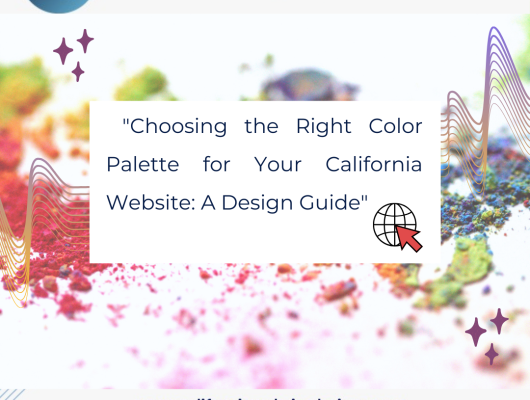In the ever-evolving digital panorama, harmony in design takes center degree when it comes to crafting websites that not simplest look precise but also paint seamlessly. Striking an appropriate balance between aesthetic attraction and practical capability in internet layout is an undertaking that each web designer and developer should embody. In this article, we delve deep into the art and technological know-how of creating websites that stand out while delivering an incredible user experience.
Achieving harmony in layout approach weaving collectively the visible elements and person-friendly capabilities of an internet site into a seamless and fascinating whole. It’s approximately ensuring that the colors, pictures, fonts, and layout not only look wonderful but also beautify the consumer’s interaction with the web page. Crafting websites that attain this balance is a tricky method that entails cautious plans, attention to detail, and an unwavering dedication to assemble the needs and expectations of the web page’s traffic. In the paragraphs that comply with this, we will uncover the precise strategies and strategies that web designers appoint to attain this delicate harmony in layout, making sure that your internet site now not only looks right but also features perfectly.
Understanding the Significance of Aesthetic Appeal
Understanding the Significance of Aesthetic Appeal is a fundamental aspect of crafting websites that achieve harmony in design. Aesthetics, often called the ‘visual first impression,’ play a pivotal role in web design. When visitors land on a website, what they see creates an immediate impact, shaping their perception of the site. Striking visuals are like a welcoming handshake, captivating users and encouraging them to explore further. To achieve this, consider the following key elements:
Choose a Cohesive Color Palette: The color palette you select holds the power to evoke emotions, set the overall tone, and establish a distinct brand identity. For example, if you’re designing a website for a children’s toy store, using vibrant, playful colors can create a cheerful and inviting atmosphere. In contrast, a professional law firm’s website might opt for subdued, authoritative colors that convey trustworthiness.
Opt for High-Quality Imagery: The visual content on your website, including images, infographics, and illustrations, can significantly impact its appeal. High-resolution images not only appear crisp and professional but also enhance the overall look, making your website visually engaging. For example, an e-commerce website selling fashion products has to function with fantastic photographs that permit clients to zoom in and examine info, ensuring a better buying experience.
Typography Matters: Typography is greater than just text; it’s a critical aspect of your website’s aesthetics. Selecting the right fonts is important for readability and aesthetics. A properly paired aggregate of fonts can create a professional and visually captivating website. For instance, the use of a conventional serif font for the main text and a modern sans-serif font for headings can create a nice evaluation. This guarantees that your content material isn’t simplest easy to examine but additionally visually appealing, enhancing the general concord in layout.
In crafting websites, the careful consideration of these aesthetic elements ensures that visitors are not only visually impressed but also more likely to engage with your content, resulting in a successful and harmonious web design.
The Importance of Practical Functionality:
While aesthetics draw visitors in, functionality keeps them engaged and encourages them to return. Practical functionality in web design is all about creating a seamless user experience. Practical functionality is the linchpin of achieving harmony in design when crafting websites. While aesthetics can capture the attention, it is the capability that definitely engages customers and encourages them to return for extra. Here’s how to attain it:
1. Mobile Responsiveness: In today’s digital panorama, where the majority of internet users access websites through cellular devices, a responsive layout is not just an alternative; it is a need. It’s critical to make sure your website not only seems visually appealing but also works seamlessly on smartphones and drugs. Imagine a capable consumer traveling your internet site on their phone, and if the internet site isn’t always optimized for cell, they might find it difficult to navigate, which could result in them leaving your site.
2. Fast Loading Speed: In a world where time is of the essence, users have limited patience for slow-loading websites. They expect web pages to load quickly and efficiently. To ensure fast loading times, you should compress images to reduce file sizes, utilize browser caching to store frequently accessed resources and optimize your website’s code. When your website loads swiftly, users are more likely to stay and explore its content.
3. Intuitive Navigation: A well-notion-out navigation menu is the spine of person-friendliness. It must be simple, logical, and smooth to use, assisting traffic to discover what they are looking for effects. Imagine a menu that is like a properly prepared bookshelf, making it smooth for customers to locate the e-book they want to read. Intuitive navigation ensures that users can seamlessly navigate via your website, improving their universal experience.
4. Clear Call-to-Actions (CTAs): Call-to-moves (CTAs) are like signposts that guide customers to take specific movements, whether it’s creating a buy, signing up for a publication, or contacting you for extra information. Crafting clean, outstanding, and engaging CTAs encourages person interplay and conversion. Think of a ‘Buy Now’ button in an online shop; if it is without problems and enticing, customers are more likely to click on it, for that reason selling income and interaction on your website.
Incorporating these practical functionality factors into your internet design no longer only complements the aesthetics but additionally guarantees a harmonious revel for users, making them much more likely to engage with your internet site and go back for future visits.

Achieving Harmony in Design
Achieving harmony in design while crafting websites that seamlessly blend aesthetics and functionality is a meticulous process that requires attention to detail at every step. Here’s a detailed breakdown of this journey in plain and simple language:
Define Your Objectives:
First matters first, before diving into design, you need to understand what your website is all approximately. What’s its purpose? Who’s your target market? Knowing your targets enables you to tailor the design as a result. For instance, if you’re creating a website for a children’s art class, the design should be vibrant and playful to engage young minds.
Wireframing and Prototyping:
Imagine building a house without a blueprint; it would be chaotic. Similarly, creating a website without wireframes and prototypes is like working blindly. These visual sketches help you plan the website’s structure and layout. Let’s say you’re developing an e-commerce site. Wireframes will help you decide where product images, descriptions, and shopping cart icons should go.
Design with User Experience in Mind:
Your website should be user-friendly and intuitive. Think about it as designing a car dashboard. You wouldn’t want a driver to struggle to find the steering wheel or gas pedal, right? The same is going to your internet site. Navigation menus, buttons, and content ought to be positioned logically in order that users can without difficulty find what they’re searching out.
Test and Iterate:
Creating a website isn’t a one-and-done task. You need to regularly test it. Imagine you bake a new cake recipe and ask friends to taste it. They might suggest more sugar or a different frosting. Similarly, gathering feedback from real users helps you make necessary improvements. For example, if your website has a contact form, users might find it confusing, so you can make it more user-friendly based on their feedback.
Mobile Optimization:
In trendy international, most human beings use their smartphones to access websites. So, it’s essential to ensure your internet site seems and work perfectly on diverse display screen sizes and orientations. This is like making sure your car can smoothly navigate different types of roads, from highways to narrow streets.
Monitor and Maintain:
Once your website is live, your work isn’t over. You need to keep an eye on its performance, just like how you check the car’s oil and tires regularly. Websites can become outdated, or they might have bugs. Regular updates and protection make certain your internet site stays clean and applicable to your audience.
By following these steps, you will not handiest create a lovely internet site but also one that features perfectly, providing fun enjoyment for your traffic. The harmony in design will make your website stand out and leave a positive influence on everybody who interacts with it.

Conclusion
In the world of net design, attaining the right harmony in design, especially for California website designers is similar to composing a symphony of elements that resonate with your target market. When crafting websites, it’s now not just about slapping on beautiful snapshots or implementing complicated functionalities. It’s about locating the sweet spot in which aesthetics and functionality converge seamlessly. For example, think about a visually beautiful e-trade website. The product pix are crisp, the shade palette is inviting, and the typography is elegant. But it is no longer just about the looks.
The website hundreds hastily, and the navigation is so intuitive that even a first-time visitor can without difficulty locate what they’re searching out. This is where harmony in layout shines. It’s approximately ensuring that visual appeal and person-friendliness work hand in hand, making your website a pleasing vicinity for your audience to explore. Crafted with precision, a harmonious website now not handiest outranks the competition but also leaves an indelible mark inside the good-sized virtual panorama.
Frequently Asked Questions
Q1. What is the significance of harmony in design?
Harmony in design refers back to the balance between visible aesthetics and sensible functionality. It guarantees that an internet site now not handiest looks appealing but also capabilities seamlessly, presenting great personal enjoyment.
Q2. How can I pick out the proper shade palette for my website?
To pick out the right color palette, recollect your logo identification and audience. Choose colors that resonate with your message and evoke the favored feelings.
Q3. What position does typography play in net design concord?
Typography is essential for readability and aesthetics. It includes deciding on fonts that align with your internet site’s average look and feel and ensure a professional look.
Q4. Why is cell responsiveness critical in internet design?
Mobile responsiveness is important because a large portion of customers get entry to websites on cellular gadgets. It guarantees your website adapts to distinctive display sizes, presenting a consistent personal enjoyment.
Q5. How can I optimize my internet site’s loading velocity?
Optimizing loading speed entails strategies like picture compression, browser caching, and code optimization. These measures make sure your internet site hundreds fast, keeping users engaged.
Q6. What makes a navigation menu intuitive and user-pleasant?
An intuitive navigation menu is one that is simple to understand and logically prepared. It enables site visitors to find the records they are searching for without confusion.
Q7. What are the key factors of a properly-crafted name-to-action (CTA)?
Effective CTAs are clear, concise, and visually wonderful. They manual users to take unique actions, which include creating a buy or signing up for an e-newsletter.
Q8. How can I achieve stability among aesthetics and capability in web layout?
To strike the best balance, begin by way of defining your website’s goals, creating wireframes, designing with the consumer experience in thoughts, taking a look at and iterating, optimizing for mobile, and often revealing and holding your web page.
Q9. What are a few common design errors that should be avoided in net design?
Common layout errors include cluttered layouts, poor color alternatives, sluggish loading instances, uncertain navigation, and neglecting mobile responsiveness. Avoiding these pitfalls is vital for harmony in layout.
Q10. How can I make certain my website resonates with the audience?
To resonate with your target audience, conduct thorough research to understand their needs and preferences. Tailor your layout, content material, and functionality to address those particular necessities, developing a website that absolutely connects with your audience
.






